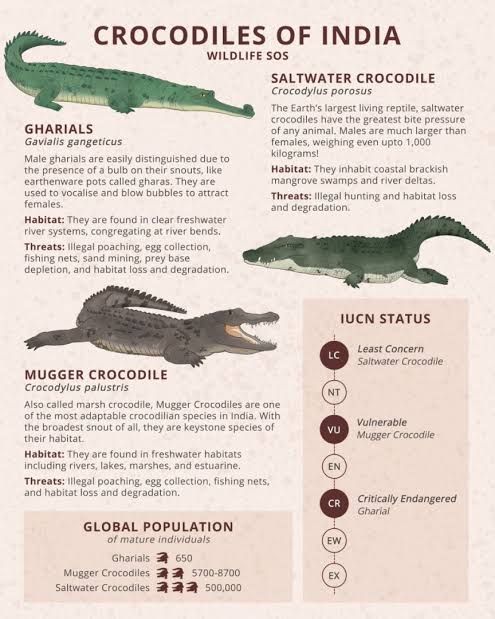Context:
Odisha recently celebrated World Crocodile Day on 17 June. In 2025, India is observing 50 years of its Crocodile Conservation Programme. This national effort, which began in 1975, is one of the country’s most successful examples of species recovery. Odisha played a key role in starting and sustaining this programme.
Background
The Crocodile Conservation Project was launched on April 1, 1975, with support from the Government of India and the Food and Agriculture Organization (FAO) of the United Nations. The aim was to protect all three native crocodilian species of India:
- Gharial (Gavialis gangeticus)
- Saltwater crocodile (Crocodylus porosus)
- Mugger or marsh crocodile (Crocodylus palustris)
At the time of the project’s launch, all three species were at risk of extinction due to habitat loss, hunting, and human disturbance.
Odisha’s Role
Odisha became the centre of India’s first scientific crocodile conservation work. The state is the only one in the country where all three crocodilian species are found in the wild. Specific sites in Odisha were identified for each species:
- Tikarpada for gharials (Mahanadi River)
- Dangamal for saltwater crocodiles (Bhitarkanika mangroves)
- Ramatirtha for muggers (river stretches in Mayurbhanj district)
In 1975, Odisha also became the first state to set up crocodile incubation and rearing centres. These centres collected eggs laid in the wild, incubated them under controlled conditions, and reared hatchlings until they reached a safe size for release into natural habitats.
The first successful hatchings took place in June 1975 at Tikarpada and Dangamal, just two months after the project began.
Major Achievements
- Odisha was the first state to appoint trained wildlife biologists for crocodile conservation.
- It established breeding pools for gharials at Nandankanan Zoo and Dangamal.
- It carried out the first release of captive-reared gharials and saltwater crocodiles into the wild.
- Odisha also participated in international collaborations, including the import of an adult male gharial from the Frankfurt Zoological Society to improve breeding.
Bhitarkanika and Satkosia were declared protected areas for crocodiles and later upgraded to National Park and Tiger Reserve status.
Current Status:
- India now holds about 80% of the world’s wild gharial population, estimated at around 3,000 individuals.
- The saltwater crocodile population in the wild has increased to about 2,500, with the largest population in Bhitarkanika, Odisha.
- The mugger crocodile has also made a strong recovery, with wild numbers now estimated between 8,000 and 10,000.
New Gharial Project:
In March 2025, a new national conservation project for gharials was announced. This project aims to reintroduce gharials into their former habitats across the Ganges and its tributaries, as well as into the Brahmaputra and Indus River systems. The project also plans to strengthen the existing population in the Mahanadi River in Odisha.
Conclusion:
India’s crocodile conservation efforts over the last 50 years have led to a significant increase in wild populations of all three species. Odisha’s early and continued efforts in conservation, research, and habitat protection have played a central role in this success. As the programme enters its sixth decade, further steps are being planned to expand and strengthen crocodile conservation across the country.







